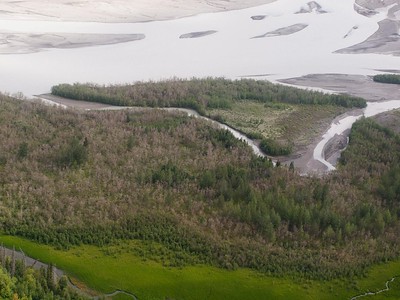Hardwood Stem Decays
Valsa melanodiscus Otth.
Valsalnicola spp. D. M. Walker & Rossman
Melanconis sp. Tul. & C. Tul.
and other fungi
Host(s) in Alaska:
thin-leaf alder (Alnus incana ssp. tenuifolia)
Siberian alder (Alnus viridis ssp. fruticosa)
Sitka alder (Alnus viridis ssp. sinuata)
red alder (Alnus rubra)
Habitat(s): main stem, branches
Content prepared by Lori Winton, PhD Forest Pathologist, Forest Health Protection, loretta.winton@usda.gov.

LINKS TO RESOURCES & PUBLICATIONS
Hollingsworth, T.N., Lloyd, A.H., Nossov, D.R., Ruess, R.W., Charlton, B.A. and Kielland, K., 2010. Twenty-five years of vegetation change along a putative successional chronosequence on the Tanana River, Alaska. Canadian Journal of Forest Research 40(7), pp. 1273-1287.
Nossov, D.R., Hollingsworth, T.N., Ruess, R.W. and Kieland, K., 2011. Development of Alnus tenuifolia stands on an Alaskan floodplain: Patterns of recruitment, disease and succession. Journal of Ecology 99(2), pp. 621-633.
Nossov, D.R., Ruess, R.W. and Hollingsworth, T.N., 2010. Climate sensitivity of thinleaf alder growth on an interior Alaskan floodplain. Ecoscience 17(3), pp. 312-320.
Rorhs-Richey, J.K., Mulder, C.P.H., Winton, L.M. and Stanosz, G., 2011. Physiological performance of an Alaskan shrub (Alnus fruticosa) in response to disease (Valsa melanodiscus) and water stress. New Phytologist 189(1), pp. 295-307.
Rorhs-Richey, J.K., Winton, L.M. and Stanosz, G.R., 2011. Response of Alnus fruticosa to inoculation with Valsa melanodiscus in roadside and forested environments. Canadian Journal of Plant Pathology 33(4), pp. 532-540.
Ruess, R.W., McFarland, J.M., Trummer, L.M. and Rorhs-Richey, J.K., 2009. Disease-mediated declines in N-fixation inputs by Alnus tenuifolia to early-successional floodplains in interior and south-central Alaska. Ecosystems 12(3), pp. 489-502.
Stanosz, G.R., Trummer, L.M., Rorhs-Richey, J.K., SMITH, D.R., Adams, G.C. and Worrall, J.J., 2011. Response of Alnus tenuifolia to inoculation with Valsa melanodiscus. Canadian Journal of Plant Pathology 33(2), pp. 202-209.
Worrall, J.J., 2009. Dieback and mortality of Alnus in the Southern Rocky Mountains, USA. Plant Disease 93(3), pp. 293-298.
Worrall, J.J., Adams, G.C. and Tharp, S.C., 2010. Summer heat and an epidemic of Cytospora canker of Alnus. Canadian Journal of Plant Pathology 32(3), pp. 376-386.
During ground surveys in Southcentral and the Interior, minor alder canker was recorded in 2021 at four locations near Anchorage and Delta Junction. From the air, almost 140 acres of alder dieback were observed in Southcentral between Denali State Park and the Caribou Hills on the Kenai Peninsula. Diagnostic fungal structures cannot be seen from the air, but dieback symptoms on thin-leaf alder are usually caused by Valsa melanodiscus and can culminate in mortality. Other canker causing fungi, including a species of Valsalnicola, are more prevalent on Sitka and Siberian alder. Significant alder dieback began in 2003 and peaked between 2011 and 2014; since then, alder canker damage has been decreasing. We have mapped it on all alder shrub species throughout most of the state. Alder dieback has frequently been aerially mapped throughout Southeast, however canker diagnosis on the ground has mainly been along the Stikine River.
When alder canker roadside surveys were repeated in 2016 after the inaugural survey in 2006, alder canker was detected at twice as many monitoring sites and showed a marked increase in canker incidence on Sitka and Siberian alder. Alder canker has also been confirmed on Sitka alder in Southeast Alaska, but damage there has not been severe. The increase in disease incidence detected through the 2016 survey is consistent with peaks in aerially mapped damage in 2011 and 2014 since the initial survey was implemented.

On thin-leaf alder, dieback is usually due to girdling cankers (localized dead and dying areas) caused by the fungus Valsa (Cytospora) melanodiscus. Cankers can grow rapidly and as the pathogen kills the phloem, cambium, and outer xylem it partially or completely girdles branches and/or main stems. Sprouting is common below dead tissue. Although V. melanodiscus is the most common and virulent pathogen causing cankers on thin-leaf alder, there are a number of other fungi that cause very similar cankers. Cankers also cause dieback upon Sitka alder and Siberian alder. However, V. melanodiscus is not the main culprit on these two species. Instead, we have found fungal species new to science, known species with expanded ecological roles, and a rather large and diverse community of visually similar canker pathogens on alder. The fungi that cause alder canker are presumably native and usually relatively benign fungi for which conditions have changed to their advantage. Red-brown foliar symptoms of alder defoliation (caused by insects) and dieback (caused by canker fungi) appear similar from the air but can be distinguished. Valsa melanodiscus was identified as the main causal fungus; however, several other canker fungi also contribute to thin-leaf alder dieback. Dieback has been increasing on Sitka alder in Southcentral and Siberian alder in the Interior since about 2014. Alder canker has also been confirmed on Sitka alder in Southeast Alaska (near Haines and along the Stikine and Taku Rivers), but damage there has not been severe.
Why have these presumably native pathogens caused unprecedented damage in the past decade? Evidence suggests that water stress due to climate warming is linked to increased canker incidence and severity (Ruess et al. 2009, Worrall et al. 2010, Rohrs-Richey et al. 2011). In addition, canker mortality is greater on thin-leaf alder stressed by defoliation from the invasive insect, green alder sawfly (Monsoma pulveratum), first found in Alaska in 2004. Over the next decade or two the expected increasing temperature trends are conducive to making an already severe epidemic even more damaging. Continued alder mortality poses a considerable threat to areas that are dependent on alder for its nitrogen-fixing contribution to soil nutrition. In densely populated, early successional floodplains, high disease severity will quickly reduce total ecosystem nitrogen inputs. Changes in successional processes and ecosystem function are expected over the long-term (Nossov et al. 2011). Permanent removal or reduction of thin-leaf alder from riparian ecosystems on a landscape scale would profoundly affect long-term nutrient cycling and forest productivity, aesthetic value, and allochthonous inputs to rivers and streams.
